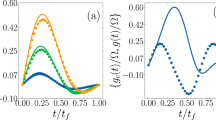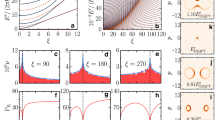Abstract
The innate complexity of solid-state physics exposes superconducting quantum circuits to interactions with uncontrolled degrees of freedom degrading their coherence. By implementing a quantum Szilard engine with an active feedback control loop, we show that a superconducting fluxonium qubit is coupled to a two-level system (TLS) environment of unknown origin, with a relatively long intrinsic energy relaxation time exceeding 50 ms. The TLSs can be cooled down, resulting in a four times lower qubit population, or they can be heated to manifest themselves as a negative-temperature environment corresponding to a qubit population of ~80%. We show that the TLSs and qubit are the dominant loss mechanism for each other and that qubit relaxation is independent of the TLS populations. Understanding and mitigating TLS environments is, therefore, not only crucial to improve the qubit lifetimes but also to avoid non-Markovian qubit dynamics.
This is a preview of subscription content, access via your institution
Access options
Access Nature and 54 other Nature Portfolio journals
Get Nature+, our best-value online-access subscription
$29.99 / 30 days
cancel any time
Subscribe to this journal
Receive 12 print issues and online access
$209.00 per year
only $17.42 per issue
Buy this article
- Purchase on Springer Link
- Instant access to full article PDF
Prices may be subject to local taxes which are calculated during checkout




Similar content being viewed by others
Data availability
Raw and processed data are publicly available via Zenodo at https://doi.org/10.5281/zenodo.7817552. Additional data are available from the corresponding authors upon reasonable request.
Code availability
The analysis script used to generate the data in the figures is publicly available via Zenodo at https://doi.org/10.5281/zenodo.7817552.
References
Ofek, N. et al. Extending the lifetime of a quantum bit with error correction in superconducting circuits. Nature 536, 441–445 (2016).
Vuillot, C., Asasi, H., Wang, Y., Pryadko, L. P. & Terhal, B. M. Quantum error correction with the toric Gottesman-Kitaev-Preskill code. Phys. Rev. A 99, 032344 (2019).
Google Quantum AI. Exponential suppression of bit or phase errors with cyclic error correction. Nature 595, 383–387 (2021).
Cai, W., Ma, Y., Wang, W., Zou, C.-L. & Sun, L. Bosonic quantum error correction codes in superconducting quantum circuits. Fundam. Res. 1, 50–67 (2021).
Grabovskij, G. J., Peichl, T., Lisenfeld, J., Weiss, G. & Ustinov, A. V. Strain tuning of individual atomic tunneling systems detected by a superconducting qubit. Science 338, 232–234 (2012).
Barends, R. et al. Coherent Josephson qubit suitable for scalable quantum integrated circuits. Phys. Rev. Lett. 111, 080502 (2013).
Risté, D. et al. Millisecond charge-parity fluctuations and induced decoherence in a superconducting transmon qubit. Nat. Commun. 4, 1913 (2013).
Pop, I. M. et al. Coherent suppression of electromagnetic dissipation due to superconducting quasiparticles. Nature 508, 369–372 (2014).
Gustavsson, S. et al. Suppressing relaxation in superconducting qubits by quasiparticle pumping. Science 354, 1573–1577 (2016).
Grünhaupt, L. et al. Loss mechanisms and quasiparticle dynamics in superconducting microwave resonators made of thin-film granular aluminum. Phys. Rev. Lett. 121, 117001 (2018).
Serniak, K. et al. Hot nonequilibrium quasiparticles in transmon qubits. Phys. Rev. Lett. 121, 157701 (2018).
Chu, Y. et al. Creation and control of multi-phonon Fock states in a bulk acoustic-wave resonator. Nature 563, 666–670 (2018).
De Graaf, S. E. et al. Two-level systems in superconducting quantum devices due to trapped quasiparticles. Sci. Adv. 6, eabc5055 (2020).
Wilen, C. D. et al. Correlated charge noise and relaxation errors in superconducting qubits. Nature 594, 369–373 (2021).
Glazman, L. & Catelani, G. Bogoliubov quasiparticles in superconducting qubits. SciPost Phys. Lect. Notes 31 (2021).
Siddiqi, I. Engineering high-coherence superconducting qubits. Nat. Rev. Mater. 6, 875–891 (2021).
Kirsh, N., Svetitsky, E., Burin, A. L., Schechter, M. & Katz, N. Revealing the nonlinear response of a tunneling two-level system ensemble using coupled modes. Phys. Rev. Mater. 1, 012601 (2017).
Andersson, G. et al. Acoustic spectral hole-burning in a two-level system ensemble. npj Quantum Inf. 7, 15 (2021).
Wang, Z. L. et al. Quantum state characterization of a fast tunable superconducting resonator. Appl. Phys. Lett. 102, 163503 (2013).
Lisenfeld, J. et al. Electric field spectroscopy of material defects in transmon qubits. npj Quantum Inf. 5, 105 (2019).
Szilard, L. Über die Entropieverminderung in einem thermodynamischen System bei Eingriffen intelligenter Wesen. Z. Phys. 53, 840–856 (1929).
Toyabe, S., Sagawa, T., Ueda, M., Muneyuki, E. & Sano, M. Experimental demonstration of information-to-energy conversion and validation of the generalized Jarzynski equality. Nat. Phys. 6, 988–992 (2010).
Koski, J. V., Maisi, V. F., Pekola, J. P. & Averin, D. V. Experimental realization of a Szilard engine with a single electron. Proc. Natl Acad. Sci. USA 111, 13786–13789 (2014).
Peterson, J. P. S., Sarthour, R. S. & Laflamme, R. Implementation of a quantum engine fuelled by information. Preprint at https://arxiv.org/abs/2006.10136 (2020).
Bluhm, H., Foletti, S., Mahalu, D., Umansky, V. & Yacoby, A. Enhancing the coherence of a spin qubit by operating it as a feedback loop that controls its nuclear spin bath. Phys. Rev. Lett. 105, 216803 (2010).
Broadway, D. A. et al. Quantum probe hyperpolarisation of molecular nuclear spins. Nat. Commun. 9, 1246 (2018).
Córcoles, A. D. et al. Exploiting dynamic quantum circuits in a quantum algorithm with superconducting qubits. Phys. Rev. Lett. 127, 100501 (2021).
Gold, A. et al. Entanglement across separate silicon dies in a modular superconducting qubit device. npj Quantum Inf. 7, 142 (2021).
Satzinger, K. J. et al. Realizing topologically ordered states on a quantum processor. Science 374, 1237–1241 (2021).
Grünhaupt, L. et al. Granular aluminium as a superconducting material for high-impedance quantum circuits. Nat. Mater. 18, 816–819 (2019).
Gusenkova, D. et al. Quantum nondemolition dispersive readout of a superconducting artificial atom using large photon numbers. Phys. Rev. Applied 15, 064030 (2021).
Yang, A. et al. Simultaneous subsecond hyperpolarization of the nuclear and electron spins of phosphorus in silicon by optical pumping of exciton transitions. Phys. Rev. Lett. 102, 257401 (2009).
Wang, H.-J. et al. Sensitive magnetic control of ensemble nuclear spin hyperpolarization in diamond. Nat. Commun. 4, 1940 (2013).
Solomon, I. Relaxation processes in a system of two spins. Phys. Rev. 99, 559–565 (1955).
Vögeli, B. The nuclear Overhauser effect from a quantitative perspective. Prog. Nucl. Magn. Reson. Spectrosc. 78, 1–46 (2014).
Klimov, P. V. et al. Fluctuations of energy-relaxation times in superconducting qubits. Phys. Rev. Lett. 121, 090502 (2018).
Thorbeck, T., Eddins, A., Lauer, I., McClure, D. T. & Carroll, M. TLS dynamics in a superconducting qubit due to background ionizing radiation. Preprint at https://arxiv.org/abs/2210.04780 (2022).
Neeley, M. et al. Process tomography of quantum memory in a Josephson-phase qubit coupled to a two-level state. Nat. Phys. 4, 523–526 (2008).
Lisenfeld, J. et al. Measuring the temperature dependence of individual two-level systems by direct coherent control. Phys. Rev. Lett. 105, 230504 (2010).
Lisenfeld, J. et al. Decoherence spectroscopy with individual two-level tunneling defects. Sci. Rep. 6, 23786 (2016).
Lee, K. H., Holmberg, G. E. & Crawford, J. H. Optical and ESR studies of hole centers in γ-irradiated Al2O3. Phys. Stat. Sol. A 39, 669–674 (1977).
Yang, F. et al. Microscopic charging and in-gap states in superconducting granular aluminum. Phys. Rev. B 102, 104502 (2020).
Reinhold, P. et al. Error-corrected gates on an encoded qubit. Nat. Phys. 16, 822–826 (2020).
Grimm, A. et al. Stabilization and operation of a Kerr-cat qubit. Nature 584, 205–209 (2020).
Samkharadze, N. et al. High-kinetic-inductance superconducting nanowire resonators for circuit QED in a magnetic field. Phys. Rev. Applied 5, 044004 (2016).
Borisov, K. et al. Superconducting granular aluminum resonators resilient to magnetic fields up to 1 Tesla. Appl. Phys. Lett. 117, 120502 (2020).
Quintana, C. M. et al. Observation of classical-quantum crossover of 1/f flux noise and its paramagnetic temperature dependence. Phys. Rev. Lett. 118, 057702 (2017).
Reed, M. D. et al. Fast reset and suppressing spontaneous emission of a superconducting qubit. Appl. Phys. Lett. 96, 203110 (2010).
von Lüpke, U. et al. Parity measurement in the strong dispersive regime of circuit quantum acoustodynamics. Nat. Phys. 18, 794–799 (2022).
Vool, U. et al. Non-Poissonian quantum jumps of a fluxonium qubit due to quasiparticle excitations. Phys. Rev. Lett. 113, 247001 (2014).
Nsanzineza, I. & Plourde, B. L. T. Trapping a single vortex and reducing quasiparticles in a superconducting resonator. Phys. Rev. Lett. 113, 117002 (2014).
Kumar, P. et al. Origin and reduction of 1/f magnetic flux noise in superconducting devices. Phys. Rev. Applied 6, 041001 (2016).
Müller, C., Cole, J. H. & Lisenfeld, J. Towards understanding two-level-systems in amorphous solids: insights from quantum circuits. Rep. Prog. Phys. 82, 124501 (2019).
Acknowledgements
We are grateful to J. Lisenfeld and W. Wulfhekel for insightful discussions as well as A. Lukashenko and L. Radtke for technical assistance. Funding was provided by the Alexander von Humboldt Foundation in the framework of a Sofja Kovalevskaja award endowed by the German Federal Ministry of Education and Research, and by the European Union’s Horizon 2020 programme under no. 899561 (AVaQus). M.S. and G.C. acknowledge support from the German Ministry of Education and Research (BMBF) within the project GEQCOS (FKZ: 13N15683 and 13N15685). P.P. acknowledges support from the German Ministry of Education and Research (BMBF) within the QUANTERA project SiUCs (FKZ: 13N15209). D.R., S.G. and W.W. acknowledge support from the European Research Council advanced grant MoQuOS (no. 741276). Facilities use was supported by the KIT Nanostructure Service Laboratory. We acknowledge qKit for providing a convenient measurement software framework.
Author information
Authors and Affiliations
Contributions
M.S. and I.M.P. conceived the experiment. N.D. and Y.C. installed and supervised the real-time microwave electronics. M.S. performed the experiment, analysed the data and developed the theoretical model. I.T. and P.W. designed and fabricated the parametric amplifier. R.G. and O.S. provided the real-time microwave electronics for preliminary experiments. P.P. and N.G. carried out additional measurements for the revised manuscript. M.S. and I.M.P. wrote the manuscript. A.S. and I.M.P. supervised the project. All authors discussed the results and contributed to the final manuscript.
Corresponding authors
Ethics declarations
Competing interests
The authors declare no competing interests.
Peer review
Peer review information
Nature Physics thanks Tobias Lindström, Nathan Earnest-Noble and the other, anonymous, reviewer(s) for their contribution to the peer review of this work.
Additional information
Publisher’s note Springer Nature remains neutral with regard to jurisdictional claims in published maps and institutional affiliations.
Supplementary information
Supplementary Information
Supplementary Sections A–M and Figs. 1–12.
Rights and permissions
Springer Nature or its licensor (e.g. a society or other partner) holds exclusive rights to this article under a publishing agreement with the author(s) or other rightsholder(s); author self-archiving of the accepted manuscript version of this article is solely governed by the terms of such publishing agreement and applicable law.
About this article
Cite this article
Spiecker, M., Paluch, P., Gosling, N. et al. Two-level system hyperpolarization using a quantum Szilard engine. Nat. Phys. 19, 1320–1325 (2023). https://doi.org/10.1038/s41567-023-02082-8
Received:
Accepted:
Published:
Issue Date:
DOI: https://doi.org/10.1038/s41567-023-02082-8
This article is cited by
-
A qubit tames its environment
Nature Physics (2023)



